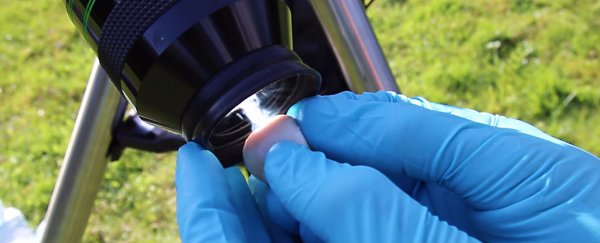
From about the time when we learn what 'eyes' and 'the Sun' are, our parents drill it into us that those things should never ever be mixed. The Sun might be 150 million km away, but that doesn't mean our delicate corneas - the transparent outer layer of your eye - can withstand the incredibly damaging ultraviolet (UV) rays beaming down into them when we try to stare directly into the white-hot circle in the sky.
But if you put a lens between your eyes, the Sun, and its harmful UV rays, surely that's enough to protect you from cornea sunburn, right? Hell no, and the video above from British astronomer and BBC presenter, Mark Thompson, shows you in gruesome detail why.
Armed with a fresh pig's eye from his local butcher, Thompson focusses his 80 mm backyard telescope with 50x magnification in on the Sun, and holds the eye up to the lens.
Being similar to a human's eye in terms of anatomy, vasculature, and photoreceptor distribution, a pig's eye gives us a pretty good approximation for what would happen to us if we attempted to get a zoomed-in view of our star.
At first, nothing seems to happen, but after about 20 seconds, the eye starts giving off smoke, and the flesh is literally being cooked like it's being held under a magnifying glass on a sunny day.
Immediately, we can see a hole burnt right through the cornea and the lens - the nearly transparent structure suspended behind the iris that helps focus light rays. When Thompson dissects the eyeball, he finds a brown patch of damaged tissue on the retina, suggesting that the UV rays had penetrated well below the surface layers of the eye.
"If this was a human eye there would almost certainly be some pretty severe damage, and that is why it's a very, very bad idea to look at the Sun through the eye piece of a telescope," he says.
Now, a couple of things that need to be pointed out: this isn't a proper experiment, performed under controlled conditions with multiple samples and a control group for comparison, and the pig's eye wasn't hooked up to the tear ducts that would usually be excreting a protective layer of moisture over everything, so we can't take these results as gospel.
But even if the actual results with a living human eye are in any way similar, it's reason enough to keep those delicate peepers away from your telescope lens - something we all need to remember next week when we'll want to watch Mercury pass across the face of the Sun.
On May 9, Mercury's transit will cast a small black silhouette in front of the solar disk from 9:12am to 4:42am AEST (12:12 to 19:42 BST and 7:12pm to 2:42pm EST) - the first transit of the planet across the Sun since 2006. So how do we - safely - watch this amazing cosmic event?
As Dominic Ford from the British Astronomical Association (BAA) advises:
"The safest way to view the transit yourself is to buy a purpose-built solar projection box.
These typically consist of a cardboard box with a small lens on one side. They project an enlarged image of the Sun onto a white cardboard sheet inside the box. Once the transit is over, they're also great for observing sunspots. They are safe to use, quick to set up, and ideal for use with children and groups."
If you have a backyard telescope, you can easily project an image of the Sun onto a piece of white card. Head over the to BAA website for more information on how to do that safely to avoid damaging your equipment.
And for an astronomical event that's a little easier to view, check out the meteor shower that's happening right now, courtesy of Halley's comet. You're welcome.
